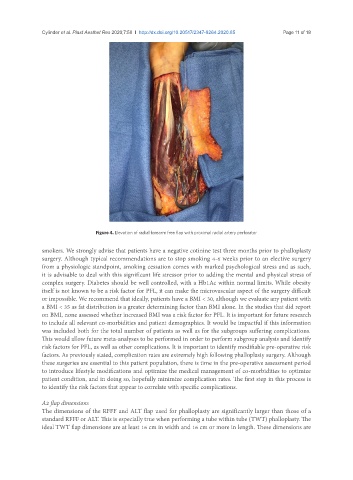Page 677 - Read Online
P. 677
Cylinder et al. Plast Aesthet Res 2020;7:58 I http://dx.doi.org/10.20517/2347-9264.2020.85 Page 11 of 18
Figure 4. Elevation of radial forearm free flap with proximal radial artery perforator
smokers. We strongly advise that patients have a negative cotinine test three months prior to phalloplasty
surgery. Although typical recommendations are to stop smoking 4-6 weeks prior to an elective surgery
from a physiologic standpoint, smoking cessation comes with marked psychological stress and as such,
it is advisable to deal with this significant life stressor prior to adding the mental and physical stress of
complex surgery. Diabetes should be well controlled, with a Hb1Ac within normal limits. While obesity
itself is not known to be a risk factor for PFL, it can make the microvascular aspect of the surgery difficult
or impossible. We recommend that ideally, patients have a BMI < 30, although we evaluate any patient with
a BMI < 35 as fat distribution is a greater determining factor than BMI alone. In the studies that did report
on BMI, none assessed whether increased BMI was a risk factor for PFL. It is important for future research
to include all relevant co-morbidities and patient demographics. It would be impactful if this information
was included both for the total number of patients as well as for the subgroups suffering complications.
This would allow future meta-analyses to be performed in order to perform subgroup analysis and identify
risk factors for PFL, as well as other complications. It is important to identify modifiable pre-operative risk
factors. As previously stated, complication rates are extremely high following phalloplasty surgery. Although
these surgeries are essential to this patient population, there is time in the pre-operative assessment period
to introduce lifestyle modifications and optimize the medical management of co-morbidities to optimize
patient condition, and in doing so, hopefully minimize complication rates. The first step in this process is
to identify the risk factors that appear to correlate with specific complications.
A2 flap dimensions
The dimensions of the RFFF and ALT flap used for phalloplasty are significantly larger than those of a
standard RFFF or ALT. This is especially true when performing a tube within tube (TWT) phalloplasty. The
ideal TWT flap dimensions are at least 16 cm in width and 16 cm or more in length. These dimensions are

